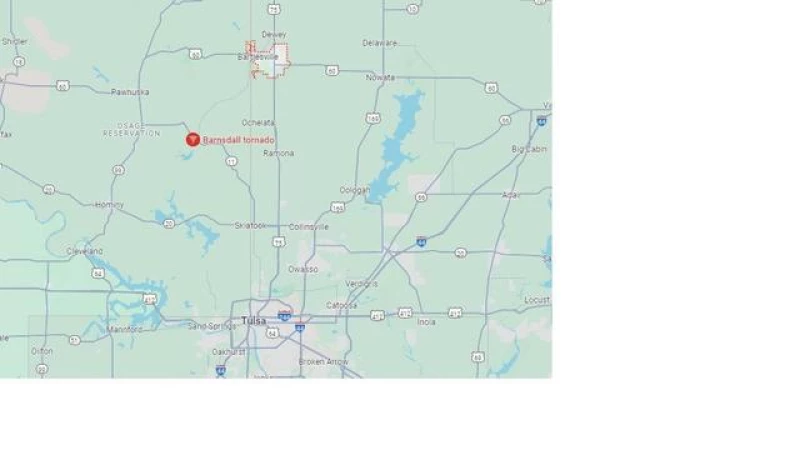Amid a series of powerful storms, a tornado wreaked havoc in a small northeast Oklahoma city, destroying homes, toppling trees, and power lines. The 1,000-person city of Barnsdall, located about a 40-minute drive north of Tulsa, was hit by the tornado on Monday night. Nearby Bartlesville also suffered a "direct hit" from a funnel, as reported by Washington County Emergency Director Kary Cox.
According to meteorologist Stephen Nehrenz from CBS Tulsa affiliate KOTV, the Hampton Inn in Bartlesville was impacted by the tornado, with most of the building's roof being lost. Fortunately, initial reports suggest that everyone at the hotel is safe.
Law enforcement officers and residents assessed the damage in a Barnsdall neighborhood amidst lightning and heavy rain, as shown in local TV news footage. The tornado tore off the roof of one house, hurling it back onto the street. Osage County Sheriff Eddie Virden informed KOTV that as of 11 p.m. local time, there were no confirmed fatalities.
Search and rescue efforts were underway at Osage Nation Reservation, authorities said.
Some 28,000 homes and businesses were in the dark in Oklahoma as of 3:30 a.m. local time.
The National Weather Service in Tulsa had warned earlier in the evening that "a large and life-threatening tornado" was headed toward Barnsdall, with wind gusts up to 70 mph. Meteorologist Brad McGavock said information on the tornado's size and how far it traveled wasn't immediately available Monday night.
The storms began earlier Monday with gusty winds and rain. But after dark, tornadoes were spotted skirting northern Oklahoma. At one point in the evening, a storm in the small town of Covington had "produced tornadoes off and on for over an hour," the National Weather Service said. Throughout the area, wind farm turbines spun rapidly in the wind and blinding rain.
In Kansas, some areas were pelted by apple-sized hail 3 inches in diameter.
The storms tore through Oklahoma as areas including Sulphur and Holdenville were still recovering from a tornado that killed four and left thousands without power late last month. Both the Plains and Midwest have been hammered by tornadoes this spring.
The State Emergency Operations Center in Oklahoma, located in a bunker near Oklahoma City, remained activated following the deadly storms over the weekend.
According to the weather service, over 3.4 million people, 1,614 schools, and 159 hospitals in Oklahoma, parts of southern Kansas, and northern Texas were at risk of severe tornadoes on Monday.
Monte Tucker, a farmer and rancher in Sweetwater, Oklahoma, spent the day securing his equipment in preparation for the storm. He offered shelter in his reinforced safe room to neighbors in case of dangerous weather.
"We built a house 10 years ago, and my stubborn wife insisted on a safe room," Tucker explained, highlighting the room's reinforced concrete walls.
Oklahoma and Kansas were both under a high-risk weather warning on Monday.
Bill Bunting, deputy director of the Storm Prediction Center, emphasized the rarity of such warnings, stating that it signifies the highest level of threat. The last time a warning of this magnitude was issued was on March 31, 2023, during a severe storm that affected several states in the South and Midwest.
The heightened risk is a result of a unique combination: Strong winds reaching up to approximately 75 mph were sweeping through Colorado's densely populated Front Range area, including Denver, on Monday.
These winds were generated by a low pressure system situated north of Colorado, which was also drawing moisture from the Gulf of Mexico, escalating the potential for severe weather on the Plains, as outlined by the National Weather Service's office in Denver.
Colorado was not under threat of tornadoes or thunderstorms.
The upcoming week is anticipated to be stormy across the United States. The eastern U.S. and the South are projected to bear the brunt of adverse weather conditions for the remainder of the week, encompassing cities like Indianapolis, Memphis, Nashville, St. Louis, and Cincinnati, where over 21 million individuals reside. Conditions are expected to improve over the weekend.
Meanwhile, floodwaters in the Houston area have started to recede on Monday following several days of intense rainfall in southeastern Texas, which resulted in flooded neighborhoods and numerous high-water rescues.







